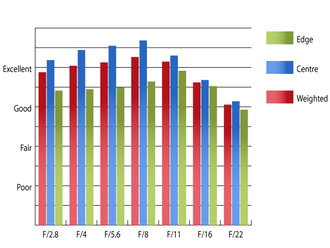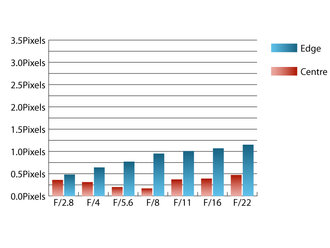Pentax DA 40mm f/2.8 XS Pancake
Pentax DA 40mm F/2.8 XS Pancake Lens Performance
Sharpness is excellent in the centre from maximum aperture, and very good towards the edges. Stopping the lens down improves clarity across the frame further, with peak quality across the frame being reached between f/8 and f/11, where sharpness in the centre is outstanding, and approaching excellent levels towards the edges. Resolution @ 40mm | How to read our chartsThe blue column represents readings from the centre of the picture frame at the various apertures and the green is from the edges. Averaging them out gives the red weighted column.The scale on the left side is an indication of actual image resolution. The taller the column, the better the lens performance. Simple. For this review, the lens was tested on a Pentax K-01 using Imatest. |
Levels of chromatic fringing are within acceptable levels at wider apertures, but the amount of CA towards the edges of the frame increases as the lens is stopped down. At apertures of f/11 and beyond, CA levels exceed one pixel width, which may pose issues for images with high contrast edges towards the outer limits of the frame.
 Chromatic aberration @ 40mm | How to read our chartsChromatic aberration is the lens' inability to focus on the sensor or film all colours of visible light at the same point. Severe chromatic aberration gives a noticeable fringing or a halo effect around sharp edges within the picture. It can be cured in software.Apochromatic lenses have special lens elements (aspheric, extra-low dispersion etc) to minimize the problem, hence they usually cost more. For this review, the lens was tested on a Pentax K-01 using Imatest. |
Falloff of illumination towards the corners is well controlled for a lens of this type. At f/2.8, the corners are only 1.06 stops darker than the image centre. Visually uniform illumination is achieved with the lens stopped down to f/5.6 or beyond.
Barrel distortion is slightly high for a fixed focal lens. Here Imatest detected 3.56% barrel distortion, which shouldn't pose too many issues for general photography, but may be too strong for work where straight lines are critical. Luckily the distortion pattern is uniform across the frame, so this distortion should be relatively easy to correct in image editing software.
Add your message
Login required
Please login here or if you've not registered, you can register here. Registering is safe, quick and free.
Please login here or if you've not registered, you can register here. Registering is safe, quick and free.
photodo Stats
1102 lenses
428 MTF tests
74 in-depth photodo reviews
100+ users join each day
Help the lens community by reviewing or rating a lens today via our lens search
428 MTF tests
74 in-depth photodo reviews
100+ users join each day
Help the lens community by reviewing or rating a lens today via our lens search
Latest Lens Reviews
- Chinon 28mm f/2.8 Vintage Lens Review
- Canon EF 70-200mm f/4L IS II USM Lens Review
- Samyang AF 85mm f/1.4 EF Review
- Sigma 70mm f/2.8 DG Macro Art Review
- Samyang AF 24mm f/2.8 FE Review
- Meike 50mm f/1.7 Review
- Tamron 70-210mm f/4 Di VC USD Review
- Lensbaby Burnside 35mm f/2.8 Review
- Asahi Super Takumar 50mm f/1.4 Review
- Asahi Super-Multi-Coated Takumar 135mm f/3.5 Review
